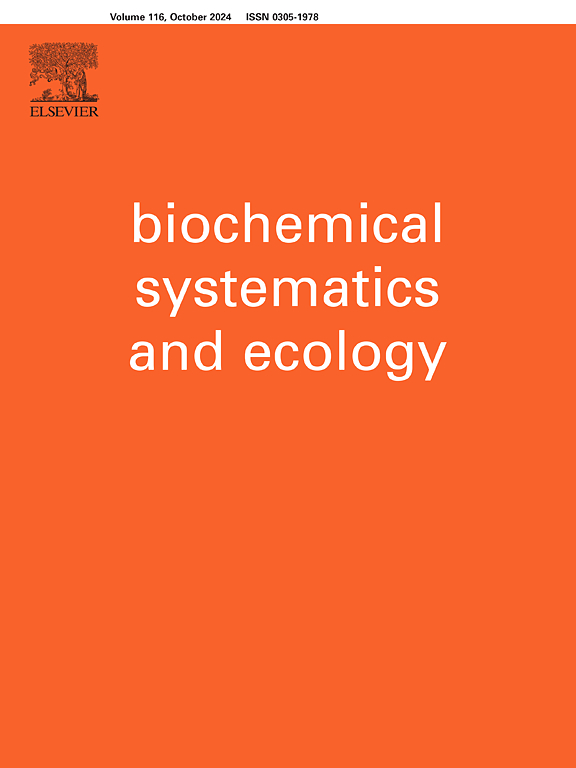花楸精油的化学成分、抗氧化及抗菌活性
IF 2
4区 生物学
Q4 BIOCHEMISTRY & MOLECULAR BIOLOGY
引用次数: 0
摘要
药用植物是取之不尽、用之不竭的植物化学物质储存库,具有多种生物学特性,这些特性已被传统地唤起并被科学地证实。本研究采用GC/MS技术对采自Guercif地区的混合枝花精油的挥发性成分进行了分析,并对其抗氧化和抗菌活性进行了研究。色谱分析表明,挥发性化合物含量最高的是α-蒎烯(77.30%)。DPPH、FRAP和ABTS的IC50值分别为0.41±0.02 mg/ml、0.98±0.06 mg/ml和2.01±0.04 mg/ml。精油对金黄色葡萄球菌和柯氏葡萄球菌的MIC值均为0.187 mg/ml。目前的研究表明,混合草可能是一种潜在的天然来源,用于制药应用的产品级抗氧化剂的生物活性化合物。本文章由计算机程序翻译,如有差异,请以英文原文为准。

Chemical composition, antioxidant, and antibacterial activities of Cladanthus mixtus essential oil
Medicinal plants constitute an inexhaustible reservoir of phytochemicals with multiple biological properties that have been evoked traditionally and proven scientifically. The current study was conducted to assess the volatile profile of Cladanthus mixtus essential oil collected from the Guercif region for its aromatic constituents using GC/MS, as well as its antioxidant and antibacterial activities. Chromatographic analysis revealed that the most abundant volatile compound was α-pinene (77.30 %). In the DPPH, FRAP, and ABTS assays, the IC50 values at 0.41 ± 0.02 mg/ml, 0.98 ± 0.06 mg/ml, and 2.01 ± 0.04 mg/ml, respectively. The essential oil was also effective against S. aureus and C. koseri with MIC value of 0.187 mg/ml for both bacterial strains. The present investigation indicates that C. mixtus can be a potential natural source of bioactive compounds for product-grade antioxidants for pharmaceutical applications.
求助全文
通过发布文献求助,成功后即可免费获取论文全文。
去求助
来源期刊

Biochemical Systematics and Ecology
生物-进化生物学
CiteScore
3.00
自引率
12.50%
发文量
147
审稿时长
43 days
期刊介绍:
Biochemical Systematics and Ecology is devoted to the publication of original papers and reviews, both submitted and invited, in two subject areas: I) the application of biochemistry to problems relating to systematic biology of organisms (biochemical systematics); II) the role of biochemistry in interactions between organisms or between an organism and its environment (biochemical ecology).
In the Biochemical Systematics subject area, comparative studies of the distribution of (secondary) metabolites within a wider taxon (e.g. genus or family) are welcome. Comparative studies, encompassing multiple accessions of each of the taxa within their distribution are particularly encouraged. Welcome are also studies combining classical chemosystematic studies (such as comparative HPLC-MS or GC-MS investigations) with (macro-) molecular phylogenetic studies. Studies that involve the comparative use of compounds to help differentiate among species such as adulterants or substitutes that illustrate the applied use of chemosystematics are welcome. In contrast, studies solely employing macromolecular phylogenetic techniques (gene sequences, RAPD studies etc.) will be considered out of scope. Discouraged are manuscripts that report known or new compounds from a single source taxon without addressing a systematic hypothesis. Also considered out of scope are studies using outdated and hard to reproduce macromolecular techniques such as RAPDs in combination with standard chemosystematic techniques such as GC-FID and GC-MS.
 求助内容:
求助内容: 应助结果提醒方式:
应助结果提醒方式:


